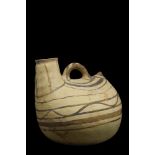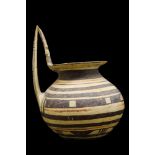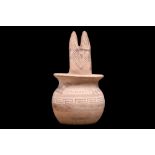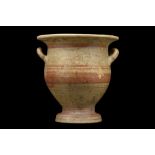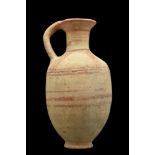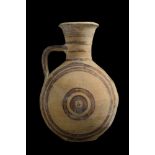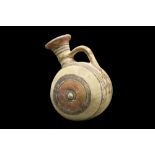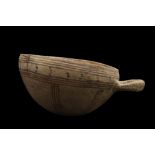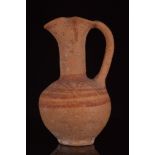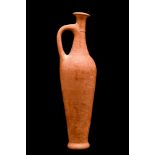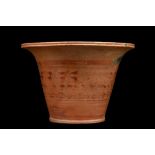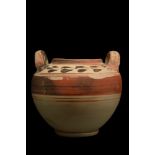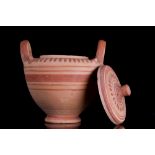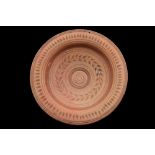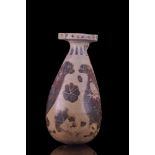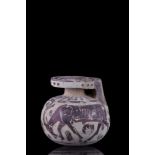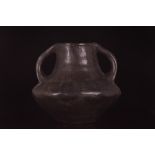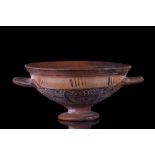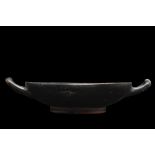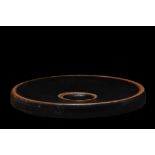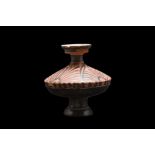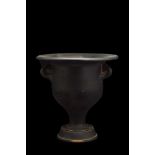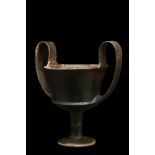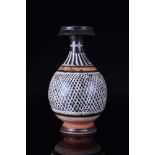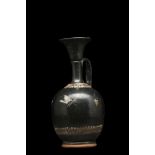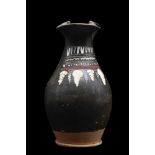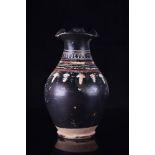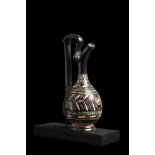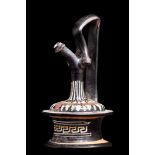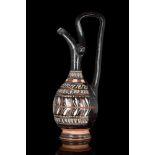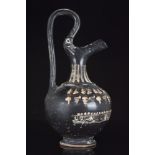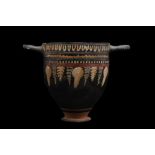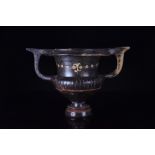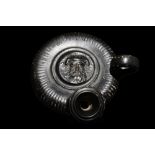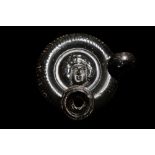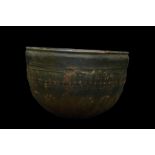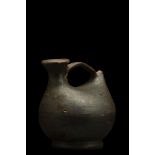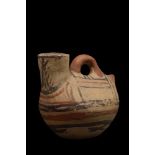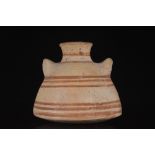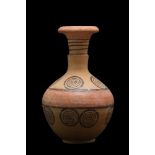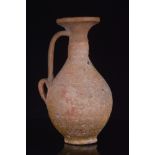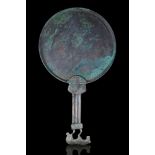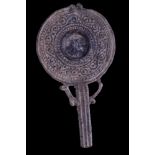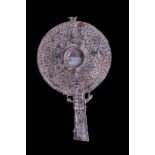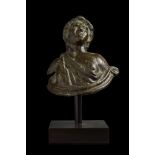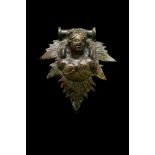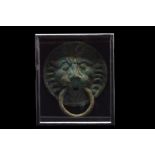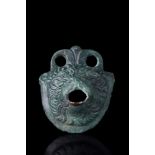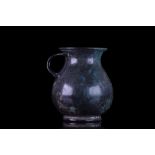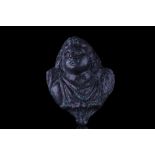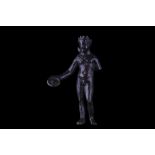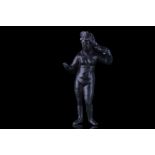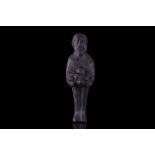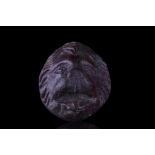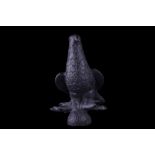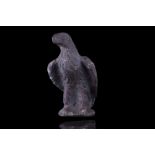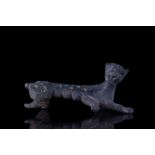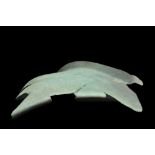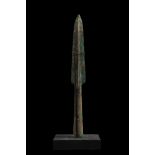Verfeinern Sie Ihre Suche
Schätzpreis
Kategorie
- Jewellery (92)
- Greek, Roman, Egyptian & Other Antiquities (85)
- Arms, Armour & Militaria (56)
- Sculpture (41)
- Ceramics (39)
- Coins (37)
- Chinese Works of Art (28)
- Glassware (25)
- Books & Periodicals (16)
- Salvage & Architectural Antiques (14)
- Porcelain (13)
- Collectables (9)
- Taxidermy & Natural History (6)
- Vintage Fashion (6)
- Classic Cars, Motorcycles & Automobilia (4)
- Furniture (4)
- Metalware (4)
- Textiles (4)
- Lighting (2)
- Islamic Works of Art (1)
- Musical Instruments & Memorabilia (1)
- Oil, Acrylic paintings & Mixed Media (1)
- Scientific Instruments (1)
- Stamps (1)
- Tools (1)
- Liste
- Galerie
Ein Abonnement der Preisliste ist notwendig um Ergebnisse, von Auktionen die vor einem längeren Zeitraum als 10 Tagen stattgefunden haben, ansehen zu können. Klicken Sie hier für mehr Informationen
GREEK DAUNIAN POTTERY ASKOS
Ca. 400-300 BC. A Daunian askos referred to as a "duck" askos with a globular body with a cylindrical neck, a flaring mouth, and a wide strap hand...
Ca. 350 BC. A lovely Daunian kyathos with a bulbous body tapering to a flat base. Narrowed neck leading to a broad, flat rim. A high strap handle ...
DAUNIAN POTTERY JAR
Ca. Late 6th/early 5th century BC. A beautiful Daunian jar with a rounded body tapering to a cylindrical neck, an everted tubular rim, and a high ...
Ca. 400 BC. A finely modelled wheel-thrown bichrome terracotta bell krater of a classic form with a flared rim and twin upraised coil-built handle...
CANAANITE HOLY LANDS POTTERY JUG
Ca. 1900 BC. A pottery jug with a strap handle, and an amphora-shaped body. Fine red bands encircle the body, and below the neck are displayed a g...
Cypro-Geometric, Ca. 1050-700 BC. A barrel jug of cream bichrome painted ware, the spherical body with encircling concentric decoration, with cros...
CYPRIOT POTTERY BARREL FLASK
Cypro-Geometric, Ca. 1050-700 BC. Of white painted ware, the spherical body with pronounced nipples and encircling concentric decoration, with cro...
Ca. 1300-1150 BC. A pottery vessel known as a milk bowl displays a tan-coloured ground that is embellished with six groups of vertical linear deco...
Ca. 1900 BC. A fine example of a coil-made, pottery jug with a trefoil spout, a strap handle, and an amphora-shaped body. Fine red bands are aroun...
Late Bronze Age, Ca. 1600-1200 BC. Wheel-made red lustrous bottle with spindle-shaped body with tapered neck fluting near mouth with everted rim, ...
Ca. 300 BC. A terracotta Messapian Kalathos, the body decorated in with two bands of red painted wreaths, in between two red painted bands. Very f...
Ca. 400-300 BC. A Messapian lebes gamikos, a delicately formed "marriage vase" with an inverted bell-shaped body and its characteristic pair of ho...
DAUNIAN LEBES GAMIKOS
Ca. 4th century BC. A Daunian lebes gamikos - "marriage vase" with an inverted bell-shaped body and its characteristic pair of horizontal strap ha...
Ca. 400-300 BC. A pottery plate with a cream background and red painted linear decoration in the tondo enclosed within a laurel band painted in th...
Ca. 600 BC. A beautiful pottery alabastron with a piriform body with a flat disk rim connected by a small loop with a neck. The exterior is adorne...
Ca. 600-500 BC. A pottery aryballos with its characteristic round body, a short neck, and a rimmed mouth with slightly inward sloping sides. A sma...
GREEK BLACKWARE ARYBALLOS
Ca. 500 BC. A blackware aryballos with its characteristic round body, a short neck, and a rimmed mouth. A small handle connects the mouth with the...
VILLANOVAN BLACKWARE IMPASTO JAR
Ca. 1100-700 BC. A well-formed blackware jar with twin symmetrical handles rising from the shoulder. The Villanovan culture is known mostly for th...
ETRUSCO-CORINTHIAN KYLIX
Attributable to the Group of the Phoenician Palmettes, Ca. 580 - 560 BC. A terracotta kylix with a hemispherical bowl, short pedestal foot, and tw...
Ca. 400-300 BC. A stemless terracotta Greek kylix (drinking cup), covered in a rich black gloss. The large, shallow body rests on a low foot that ...
ATTIC BLACKWARE FOOD PLATE
Ca. 400-300 BC. A black-glazed pottery fishplate, having an integral ring foot, wide lower collar rim, and a central circular depression. Two red-...
Ca. 340-325 BC. A ceramic lekanis of the red-figure lid decorated with palmette designs. The lid's knob handle with radiating strokes on top. The ...
Ca. 400-300 BC. A magnificent Campanian terracotta bell krater, executed in black slip. The vessel presents a pedestal base, bell-shaped body, app...
Ca. 400-300 BC. Greek black-glazed kantharos with high attenuated twin handles and a high stemmed foot with a raised ridge. Lovely hints of irides...
Ca. 340-325 BC. A rare bottle created in a pottery workshop in the Apulia region of southern Italy where potters were known for introducing additi...
GREEK GNATHIAN WARE LEKYTHOS
Ca. 400-300 BC. A fine wheel-thrown pottery lekythos with a low ring foot, a tall ovoid body, a discoid rim with a funnel mouth, and an applied ar...
Ca. 340-320 BC. An attractive blackware pottery oinchoe with a trefoil spout, decorated in the Gnathian technique with fugitive red, white, and ye...
Southern Italian, Ca.400-300 BC. A Gnathian oinochoe with trilobate spout, constricted neck, piriform body, ring base and L-shaped handle. The ext...
Ca. 350-300 BC. A metallic black glazed pottery handled oil bottle having a tapered bulbous body, high angular handle, and pour spout, stylized li...
ANCIENT GREEK GNATHIAN EPICHYSIS
Apulia, Southern Italy, Ca. 375–300 BC. A Gnathian-ware epichysis decorated with tongues on the neck, dots, zigzags and berried laurel band on the...
Ca. 400 BC. A delicate, well detailed vessel known as a prochous, formed in a black-glazed, crafted with a tall bulbous body tapering into shaped ...
GREEK GNATHIAN POTTERY PROCHOUS
Ca. 4th century BC. A pouring vessel known as a prochous, wheel-thrown and decorated with a lustrous black glaze. The vessel is defined by its dis...
Ca. 2nd half of the 4th - 1st half of the 3rd Century BC. A particularly nice and well-preserved example of a typical drinking cup from Southern I...
Ca. 350 BC. A black glazed pottery pedestal cup, having a large loop, opposing handles with flat wide thumb rests. Lower tapered bulbous rim with ...
Ca. 3rd century BC. Black glazed terracotta guttos on a small foot with a very wide and short body. On one side of the body, a long and thin spout...
Ca. 360-320 BC. A black-glazed terracotta guttos (oil-lamp filler) with a spool-shaped foot, a wheel-shaped body, a protruding ring handle, and a ...
Eastern Mediterranean, Ca. 1st century BC - 1st century AD. A decorated pottery bowl of very fine detail with a pinkish hue, covered all over in a...
Ca. 340-325 BC. A pottery askos presenting in the form of a 'duck' with a tiered foot, a bulbous body with a concave top, a petite strap handle, a...
DAUNIAN BLACK GLAZED DUCK ASKOS
Ca. 340-325 BC. A pottery askos presenting in the form of a 'duck' with a tiered foot, a bulbous body with a concave top, a petite strap handle, a...
PALAEO-MYCENAEAN PYXIS
Late Bronze Age, Ca.1300 BC. A pyxis in buff terracotta; twin lug handles on the shoulders for suspension (suspension would help in evaporation of...
CYPRIOT POTTERY BICHROME JUGLET
Cypro-Geometric Period, Ca. 1050-700 BC. A decorated pottery juglet with painted salmon color wide band and dark brown painted concentric ring ele...
HERODIAN GREEN GLAZED OINOCHOE
Judea, Ca. 37 BC-70 AD. The body of this juglet is piriform and a small ridge is present just below the cylindrical neck. The rim is thick and eve...
Ca. 5th-4th century BC. A bronze Graeco-Scythian type mirror featuring a circular face which was originally the reflective surface, a handle shape...
Ca. 100-300 AD. A beautiful lead votive mirror, with a circular disk and rectangular handle with scroll-shaped supports. The obverse is covered wi...
Ca. 100-300 AD. A lead votive mirror, with a circular disk and a flat, rectangular handle with small lateral supports. The obverse is covered with...
Ca. 100-300 AD. A massive cast-bronze fitting coming from a chariot depicting a male figure with youthful features (possibly the god Apollo, the R...
Ca. 100-300 AD. Large cast bronze hydria attachment depicting the bust of a siren having a fancy hairdo, expressive facial features, wearing a bel...
Ca. 200-300 AD. A bronze door knock shaped as a lion head handle cast in high relief within a circular border. The animal's head modelled with a p...
Ca. 1st–2nd century AD. A superbly cast lion protome with the rich full mane of overlapping wavy locks, the lion's mouth open wide, the muzzle nat...
Ca. 100-300 AD. A bronze olpe rising from a ring foot. The vessel features a globular lower body tapering to a gracefully-shaped neck and ending w...
Ca. 100-300 AD. A bronze die for casting mounts in the form of a bust of Cupid (Greek Eros) with fleshy features and curly hair. His chubby cheeks...
Ca. 100-300 AD. A bronze figurine of a young Eros, depicted in a standing pose, naked. He is striding forward with his left leg advanced, his righ...
ROMAN BRONZE VENUS FIGURINE
Ca. 1-200 AD. A cast bronze statuette of goddess Venus standing with her weight on her right leg, the left leg bent at the knee and slightly advan...
ROMAN BRONZE PRIAPUS FIGURE
Ca. 100-300 AD. A free-standing bronze statuette of the god Priapus shown with a long beard, standing with erect phallus and a pile of fruit, symb...
ROMAN BRONZE LION HEAD PHALLERA
Ca. 100-200 AD. A cast bronze phalera formed as a lion's mask. The animal's head with prominent brow and eyes, an open mouth, and a detailed mane ...
Ca. 100-200 AD. A cast bronze figurine of an eagle perching on an integral stand. Expertly cleaned and conserved, with a smooth patina. An aquila ...
ROMAN BRONZE EAGLE FIGURINE
Ca. 100 AD. A realistically modelled bronze eagle figurine, standing on a base, long wings folded, the wingtips crossed, feather detailing to the ...
ROMAN BRONZE PANTHER BROOCH
Ca. 100-200 AD. A beautiful bronze panther brooch with a slender, stretched body with recessed circles to accept enamel inlays. Catchplate to the ...
Ca. 1-100 AD. A sheet-bronze cheekpiece from a Coolus type helmet. This type of helmet was usually hammered from bronze and it was most popular du...
Ca. 800-600 BC. A socketed bronze spearhead comprising a substantial lentoid-section blade with raised midrib, and a long shaft. Hoplites were the...

